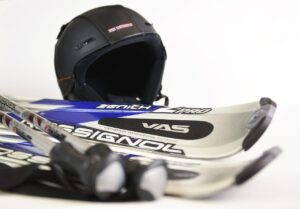When you go skiing, you should always wear a helmet. The ski helmet is designed to protect your head from injuries that may be caused by accidents or falls on the slopes.
It is also important to wear it correctly so that it will protect your head and keep it still during the fall. The following tips will help you make sure that your ski helmet fits properly:
Check the Size
- Check the Size Chart
The size chart is the first place to start, as it will tell you what size helmet should fit you. If you’re in between sizes, go up one size.
For example if your head measures 23 inches around and the Medium helmet fits snugly on your head, a Large will be more comfortable.
- Keep in mind that if you have a big noggin (or what we like to call “a large cranium”), then go with an extra large instead of going up one size from medium. This will give your brain room to expand without being squished by material or padding inside of the helmet.
Adjust the Straps and Fit System
- Adjust the straps. To make sure the helmet is snug but not too tight, you should be able to fit two fingers between your chin and the strap. The helmet should fit snugly without being too tight.
Adjust the Headband
The headband should be adjusted so it is snug. It should not be able to slide your finger between the headband and your forehead, or between the headband and the helmet.
Try it on
To make sure you’re buying the right helmet, try it on in person.
The best way to check that a helmet fits is to put it on and have someone adjust the chin straps for you. The chin straps should be snug, but not so tight that they cut into your skin or cause bleeding.
When you’re wearing your new helmet, give it a shake back and forth and then side-to-side—if the shell or lining moves at all, there’s room for improvement.
Your helmet should also sit evenly over your head without pressing down on one area more than another; if something feels like it’s poking into your scalp or causing pain in any way, try a different brand/size until you find one that fits properly!
If possible (and safe), take an old bicycle helmet with you when shopping so that you can compare their weights without having to hold them in place while trying them out on inside at home first hand
Wear it!
Once you’ve got your helmet and know how it fits, try it on in the store to make sure it’s comfortable.
When buying online or from a catalog, this is especially important because you won’t be able to see what the helmet looks like with your goggles on.
Make sure that you can move your head easily around inside of the helmet and that there aren’t any uncomfortable pressure points or areas where air can leak in. If there’s even just one thing about the fit that feels awkward, go for another size!
If possible, wear your new ski helmet on some slopes before heading out into powdery fields.
Whether or not this is possible depends on where you live: some places have access only to snowless pistes during winter months (just kidding—we all know snow’s not seasonal).
But if there is somewhere nearby where you can get some practice time under your belt before heading off into deep powder, take advantage of it!
The more familiar you are with feeling like yourself while wearing a new piece of equipment like a ski helmet , the better prepared you’ll be when things get real out there in those fresh-fallen powder beds
The ski helmet should fit snugly without being too tight
The helmet should fit snugly on your head without being too tight. It should not move around or be uncomfortably loose, but it also shouldn’t feel like it’s squeezing your skull in a vise grip.
If you are able to fit more than 2 fingers between the back of your head and the inside liner of the helmet, then it is too large for you.
The chin strap should be tight enough to keep the helmet from sliding around on your head, but not so tight that it causes pain or discomfort around your jaw area.
You should be able to comfortably speak with a friend while wearing them (just don’t make any plans for an intimate conversation).
Conclusion
We hope you’re feeling more confident about how to choose the right ski helmet for your needs. If you have any questions, please don’t hesitate to reach out! We’re here to help with anything from sizing to compatibility with other gear or accessories.
